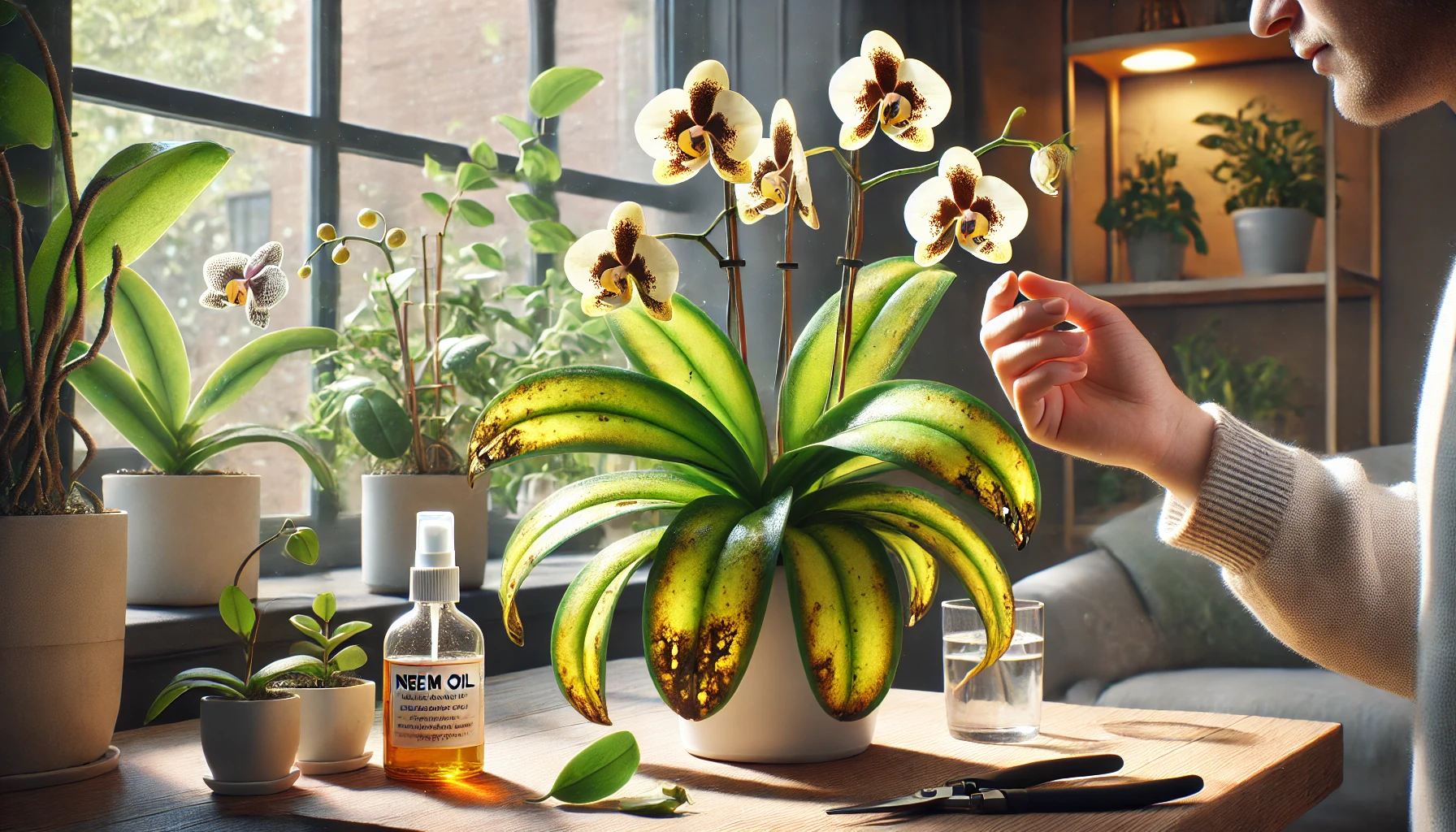Orchid leaves are one of the best indicators of the plant’s overall health. While orchids are known for their stunning flowers, their leaves can reveal issues long before the blooms are affected. Problems like yellowing, wrinkling, black spots, or browning can signal anything from improper watering to pests or diseases. Learning to diagnose and treat these issues quickly will help keep your orchid thriving.
🌱 What Do Healthy Orchid Leaves Look Like?
✔ Color: Healthy orchid leaves should be light green to medium green. Dark green leaves may indicate a lack of light, while yellow or brown leaves often signal stress.
✔ Texture: Firm, plump, and smooth. Leaves should not be wrinkled, leathery, or limp.
✔ Growth: New leaves should be strong and upright. Sudden changes in leaf shape or texture may indicate a problem.
💡 If your orchid’s leaves are changing color, texture, or showing spots, it’s a sign that something needs to be adjusted.
🌿 Common Orchid Leaf Problems and How to Fix Them
🌡 Yellowing Leaves
❌ Possible Causes:
- Natural aging (lower leaves only)
- Overwatering or root rot
- Too much direct sunlight
- Nutrient deficiencies
🛠 How to Fix It:
✔ If only one or two bottom leaves are yellowing, this is normal—the orchid is shedding old leaves.
✔ Check the roots for rot. If they are brown and mushy, repot the orchid in fresh, well-draining bark mix.
✔ Move the orchid to bright, indirect light to avoid sunburn.
✔ Fertilize with a balanced orchid fertilizer (20-20-20) at half strength once a month.
💦 Wrinkled or Limp Leaves
❌ Possible Causes:
- Underwatering or dehydration
- Root damage (overwatering in the past)
- Low humidity levels
🛠 How to Fix It:
✔ Check the roots—if they are dry and shriveled, the orchid is dehydrated.
✔ Soak the roots in lukewarm water for 10–15 minutes to rehydrate them.
✔ Increase humidity using a humidity tray or room humidifier (50–70% humidity is ideal).
✔ If roots are rotting, trim dead roots and repot in fresh bark mix.
🔥 Sunburned Leaves (Brown or Black Patches)
❌ Possible Causes:
- Too much direct sunlight
- Sudden exposure to intense light after being in low light
🛠 How to Fix It:
✔ Move the orchid to a spot with bright, indirect light (such as an east-facing window).
✔ Trim any fully dead, crispy areas with sterilized scissors.
✔ Use a sheer curtain if placing the orchid near a sunny window.
✔ Avoid sudden changes in light levels—gradually adjust if moving to a new location.
🦠 Black Spots or Brown Spots on Leaves
❌ Possible Causes:
- Fungal or bacterial infection
- Water sitting on leaves for too long
- Poor air circulation
🛠 How to Fix It:
✔ Remove affected leaves with sterilized scissors to prevent spread.
✔ Increase airflow around the plant by using a small fan.
✔ Avoid misting the leaves—water the roots only.
✔ Use a fungicide or antibacterial spray to treat infections.
🍂 Leaf Dropping (Sudden Leaf Loss)
❌ Possible Causes:
- Extreme temperature fluctuations
- Shock from repotting or moving the plant
- Pest infestation
🛠 How to Fix It:
✔ Keep the orchid in a stable environment, avoiding sudden temperature shifts.
✔ If recently repotted, give the plant time to adjust—avoid overwatering.
✔ Check for pests like spider mites or mealybugs (look under the leaves).
🐛 Pests on Orchid Leaves
❌ Possible Causes:
- Aphids, mealybugs, spider mites, or scale insects feeding on plant sap
🛠 How to Fix It:
✔ Wipe leaves with a damp cloth to remove pests.
✔ Use neem oil or insecticidal soap for persistent infestations.
✔ Keep orchids separated from infected plants to prevent spreading.
🌡 Environmental Factors That Affect Orchid Leaves
✔ Temperature: Orchids thrive at 65–75°F (18–24°C) during the day, with a slight drop at night.
✔ Humidity: Maintain 50–70% humidity to prevent dehydration.
✔ Air Circulation: Avoid stagnant air, which encourages fungal growth—use a small fan if needed.
🛡 Final Tips for Keeping Orchid Leaves Healthy
✔ Monitor your orchid’s leaves regularly—early signs of stress can prevent bigger problems.
✔ Water correctly—not too much, not too little—and always let roots dry slightly before watering again.
✔ Provide bright, indirect light—not too much sun, but enough for healthy growth.
✔ Keep humidity levels stable, especially in dry indoor environments.
✔ Treat pests immediately to prevent damage to leaves and flowers.
With proper care, your orchid’s leaves will stay vibrant, strong, and support beautiful, long-lasting blooms! 🌿✨
